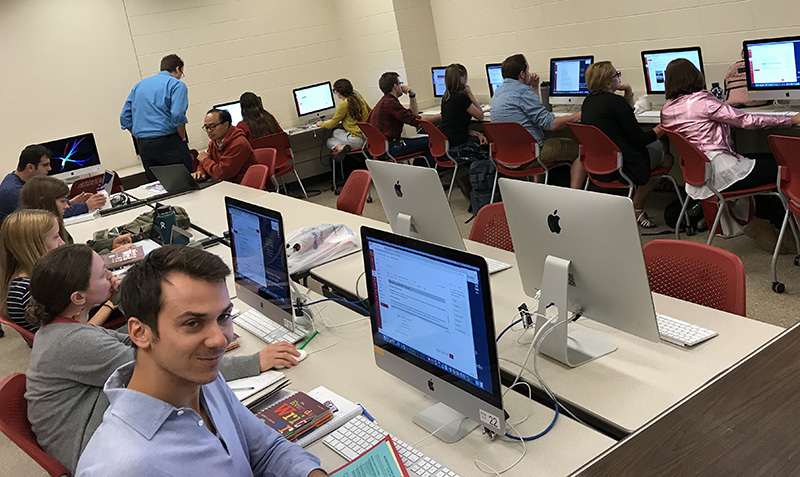English TA orientation is an intense mix of practical tips and big picture
Author: Dave Roepke
This is an archived story. The content, links and information may have changed since the publication date.
Author: Dave Roepke

First-time teaching assistants for English 150 and 250 meet with an IT specialist on the final day of their weeklong orientation before the fall semester started. Photo by Dave Roepke.
The Friday before classes started, Lindsey Huber was full of nervous energy about teaching English 150 this semester -- the new graduate student's first turn at the front of the classroom.
"I have the level of excitement like I don't know if I'm cutting the red wire or the green wire," she said.
But she felt much more prepared on Friday than she did five days earlier. Huber and 20 other first-time teaching assistants for English 150 and 250 -- Iowa State's only graded courses required for all undergraduates -- spent the week in all-day orientation sessions, an intense introduction that combines big-picture motivation and a detailed look at the curriculum with pragmatic tips and practice.
New teaching assistants have varying levels of experience as educators, but some have none. The orientation is meant to prepare them for the classroom, with teaching guidance focused on three pillars, course director and associate professor Abram Anders said:
It's impossible to develop deep knowledge about teaching in five days, but graduate assistants are often among the most popular faculty with students, in large part due to their enthusiasm, Anders said.
"When you're starting in your career, it's true that you may not have learned every lesson that a more experienced instructor may have learned, and you may not be as refined in certain areas. But typically, teaching assistants bring so much energy and so much passion. They're so excited to be teaching," he said. "I honestly feel that from Day One, TAs can be amazing instructors. That's been my experience at all levels."
TAs are essential in helping cover the large teaching load of English 150 and 250 -- the foundation courses of ISUComm, Iowa State's communication-across-the-curriculum program. This fall, there are 141 sections of the two courses combined, classes taught by 81 instructors. That would total 3,360 students if each section was full, Anders said. Combined enrollment for the year has been as high as 7,200 students, former director Barbara Blakely said in a 2018 interview.
In their first semester, new TAs have one section of English 150, often using a template syllabus, before expanding to two sections of English 250 in the spring. As they teach their fall section, they also take English 500, a course devoted to learning how to teach composition, and faculty give them feedback based on classroom observations. Many orientation topics are thumbnail versions of what's covered in English 500, said Edward Eason, an assistant teaching professor who helps lead the orientation.
"It's about laying that foundation of the essential ideas and skills they need to know for that first week," he said.
Many of the TAs have nuts-and-bolts questions, said associate teaching professor Amy Walton, an orientation instructor for four years. What should I wear? How should I introduce myself? How does grading work? Insecurity about being seen as an authority figure is common, especially for students who are coming directly to graduate school from undergraduate studies.
"They don't realize there's a mechanism already in place. Your students come in, and they see you as the instructor," she said. Making a strong first impression and showing consistency, like always starting class promptly, can maintain that momentum, she said. Scoping out the classroom ahead of time and practicing students' names are other confidence boosters.
Some sessions are more about inspiration. On orientation's first day, Anders said, the TAs are asked to recall the best teachers they've had -- to ponder what made them so good and to realize those instructors once taught for the first time, too.
But it is important to develop their own style, as well.
"You don't have to make yourself over into a cutout of some ideal teacher. You have to find a way of leveraging your strengths and supporting areas of growth where needed," Anders said.
The orientation has evolved over time, Walton said. A component on English language learners was added because students often asked about it. When Anders took over as the course director this summer, he added more modeling and role-playing exercises, she said.
"Getting up in front of their peers can be scarier than in front of a classroom," Walton said.
No matter what ground they cover, it's a daunting but productive five days.
"The students by midweek, you can tell, get this sort of heaviness. We front load so much information," Walton said. "But by the end of the week, they can envision a successful semester."
Huber said she didn't know what to expect from the orientation, though she feared it was going to be "death by Powerpoint." She was pleasantly surprised by how helpful it was. Getting a look at what they'll be learning and knowing she's part of a diverse group navigating a new challenge provided peace of mind, Huber said. Working hands-on with Canvas helped, too.
"As a whole, the big takeaway was that we're all in this together," she said. "I think we established a really good resource community."
Alana Jones also went through the orientation sessions last week, and she had some of the same initial hesitation as Huber.
"When I saw the 8-to-5 schedule, I thought, 'Oh no!'" she said.
Instead, she was impressed by how interactive the sessions were and how directly they addressed her worries. Jones has experience coaching track and cross country but wasn't sure how to keep students engaged in a classroom. She said she picked up a lot of practical advice.
"I thought it was really in-depth and well-done," she said. "I feel a lot more confident than I did on the first day coming in."